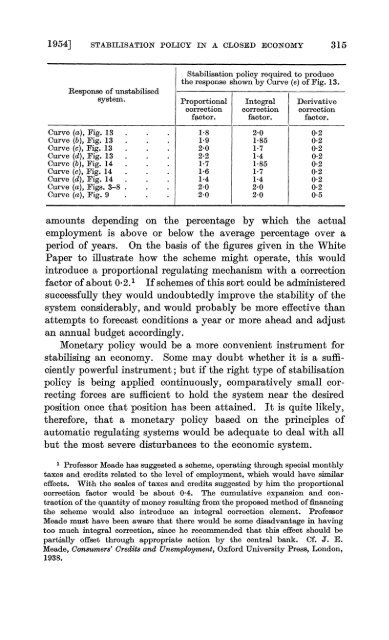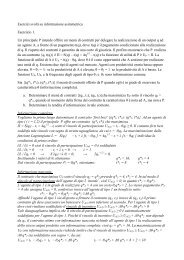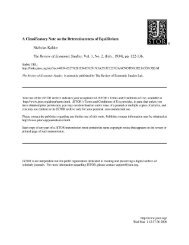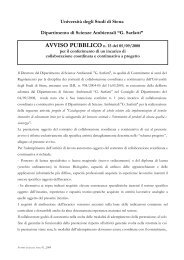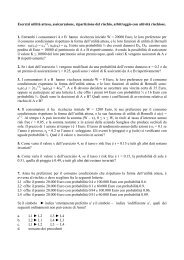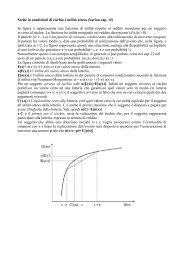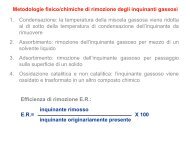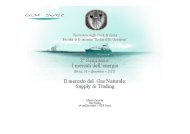Stabilisation Policy in a Closed Economy Author(s): A. W. Phillips ...
Stabilisation Policy in a Closed Economy Author(s): A. W. Phillips ...
Stabilisation Policy in a Closed Economy Author(s): A. W. Phillips ...
Create successful ePaper yourself
Turn your PDF publications into a flip-book with our unique Google optimized e-Paper software.
1954] STABILISATION POLICY IN A CLOSED ECONOMY 315<br />
<strong>Stabilisation</strong> policy required to produce<br />
the response shown by Curve (e) of Fig. 13.<br />
Response of unstabilised<br />
system. Proportional Integral Derivative<br />
correction<br />
factor.<br />
correction<br />
factor.<br />
correction<br />
factor.<br />
Curve (a), Fig. 13 1-8 2-0 0-2<br />
Curve (b), Fig. 13 .19 1F85 0-2<br />
Curve (c), Fig. 13 2-0 1-7 0-2<br />
Curve (d), Fig. 13 2-2 1-4 0-2<br />
Curve (b), Fig. 14 . 1-7 1-85 0-2<br />
Curve (c), Fig. 14 1-6 1-7 0-2<br />
Curve (d), Fig. 14 . . 14 14 0-2<br />
Curve (a), Figs. 3-8 2-0 2-0 0-2<br />
Curve (a), Fig. 9 2-0 2-0 0-5<br />
amounts depend<strong>in</strong>g on the percentage by which the actual<br />
employment is above or below the average percentage over a<br />
period of years. On the basis of the figures given <strong>in</strong> the White<br />
Paper to illustrate how the scheme might operate, this would<br />
<strong>in</strong>troduce a proportional regulat<strong>in</strong>g mechanism with a correction<br />
factor of about 0.2.1 If schemes of this sort could be adm<strong>in</strong>istered<br />
successfully they would undoubtedly improve the stability of the<br />
system considerably, and would probably be more effective than<br />
attempts to forecast conditions a year or more ahead and adjust<br />
an annual budget accord<strong>in</strong>gly.<br />
Monetary policy would be a more convenient <strong>in</strong>strument for<br />
stabilis<strong>in</strong>g an economy. Some may doubt whether it is a suffi-<br />
ciently powerful <strong>in</strong>strument; but if the right type of stabilisation<br />
policy is be<strong>in</strong>g applied cont<strong>in</strong>uously, comparatively small cor-<br />
rect<strong>in</strong>g forces are sufficient to hold the system near the desired<br />
position once that position has been atta<strong>in</strong>ed. It is quite likely,<br />
therefore, that a monetary policy based on the pr<strong>in</strong>ciples of<br />
automatic regulat<strong>in</strong>g systems would be adequate to deal with all<br />
but the most severe disturbances to the economic system.<br />
1 Professor Meade has suggested a scheme, operat<strong>in</strong>g through special monthly<br />
taxes and credits related to the level of employment, which would have similar<br />
effects. With the scales of taxes and credits suggested by him the proportional<br />
correction factor would be about 0 4. The cumulative expansion and con-<br />
traction of the quantity of money result<strong>in</strong>g from the proposed method of f<strong>in</strong>anc<strong>in</strong>g<br />
the scheme would also <strong>in</strong>troduce an <strong>in</strong>tegral correction element. Professor<br />
Meade must have been aware that there would be some disadvantage <strong>in</strong> hav<strong>in</strong>g<br />
too much <strong>in</strong>tegral correction, s<strong>in</strong>ce he recommended that this effect should be<br />
partially offset through appropriate action by the central bank. Cf. J. E.<br />
Meade, Con8umers' Credits and Unemployment, Oxford University Press, London,<br />
1938.


